 That look of skepticism on my wife’s face is in response to my explanation of why the gun was going “boom”, but the target remained perforation free. She has known me for 50 years, been married to me for just about 40. Did she really think I was going to get any smarter? I still maintain that our position relative to the equator, compounded by magnetic influences of the Santa Cruz mountains caused a shift in point of impact. Yes, I admit her alternative theory, that I should have bore sighted the newly mounted scope, had potential.
That look of skepticism on my wife’s face is in response to my explanation of why the gun was going “boom”, but the target remained perforation free. She has known me for 50 years, been married to me for just about 40. Did she really think I was going to get any smarter? I still maintain that our position relative to the equator, compounded by magnetic influences of the Santa Cruz mountains caused a shift in point of impact. Yes, I admit her alternative theory, that I should have bore sighted the newly mounted scope, had potential.
I was left with no choice but to make the journey of shame, up the firing line, to the purgatory they call the “sight in area”. A place where people show up with new scopes, on new rifles, and blast away from bayoneting distances at giant taunting targets. A place where targets are safe, shooters are not, and grandiose scope adjustments are both feverish and futile. It is a place best described by Dante Alighieri or Francis Ford Coppola. It is the place where lazy people, who try to get away with not properly preparing their firearms, are placed on public display.
 Fortunately, I invested in an inexpensive LaserLyte some time ago, one of the few truly useful firearm related gadgets I’ve purchased. I popped it into the Browning’s muzzle, pointed both at the daylight reflective target, cranked on the Burris scope adjustment until the red dot and cross hair overlaid on the bullseye and I was done. I removed the laser, took one shot that landed right in the bullseye of the real target, and headed back down the firing line for the data collection part of the day. A few things transpired before we got to this point that are probably worth mentioning.
Fortunately, I invested in an inexpensive LaserLyte some time ago, one of the few truly useful firearm related gadgets I’ve purchased. I popped it into the Browning’s muzzle, pointed both at the daylight reflective target, cranked on the Burris scope adjustment until the red dot and cross hair overlaid on the bullseye and I was done. I removed the laser, took one shot that landed right in the bullseye of the real target, and headed back down the firing line for the data collection part of the day. A few things transpired before we got to this point that are probably worth mentioning.
Rifle prep….

The most important thing about owning a new rifle is to immediately make changes to it. If the rifle performs well, you can attribute the accuracy to the gadget you installed. There are lots and lots of gadgets that can be bolted on. Hopefully, most won’t diminish the firearm’s function and quality.
I needed a scope. My eyes are not what they once were, two or three hundred year ago, and hunting by Braille has not yet caught on. I am not cheap, I may be frugal, so swiping the Burris Fullfield II 3x-9x-40mm Ballistic Plex from my 7mm WSM made perfect sense. Warne Rings and Picatinny type bases plopped on without event and, once bore sighted (see above), the combination functioned flawlessly.
I added a $35 English bridle leather Montana sling from Cabela’s. No, the sling isn’t from Montana, or England, but then neither is Cabela’s. “Montana”, in this context, is merely the name of a quick adjusting shooter’s sling that is light, comfortable and easy to use. It makes for a dead steady hold from any reasonable shooting position and it won’t make you look silly, like when you try to pretend you can shoot from shooting sticks, or from a rise on the ground that turns out to be a sleeping wolverine.
I installed a Decelerator recoil pad; softer and more resilient, something I do with all of my rifles. I can honestly say this is the first time the results made the effort a waste of time. The replacement pad did ease recoil but not to a meaningful degree.
I cleaned and lubricated the rifle in preparation for shooting. I’ve never found a dangerous goober stuck in a new gun’s bore, but it is safer to clean than to blow the preservative out ahead of a speeding bullet.
WSM Performance Expectations….
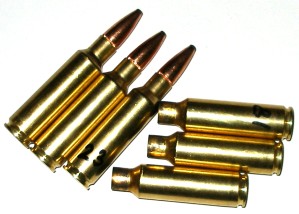 Many unflattering statements have been made about the WSM. I know, I’m responsible for more than half of them. The truth of the matter is, no WSM really outperforms the H&H counterpart it endeavors to replace. So the best you can hope for is a tie, with additional benefits to be found in accuracy, case longevity for handloaders and a broad selection of well behaved and fast handling firearms. I don’t believe I would buy one to replace an existing H&H based gun that was functioning properly. I would definitely consider one when it was time for replacement, or to fill a gap as a new application arises. This was the case with the Browning Composite Stalker.
Many unflattering statements have been made about the WSM. I know, I’m responsible for more than half of them. The truth of the matter is, no WSM really outperforms the H&H counterpart it endeavors to replace. So the best you can hope for is a tie, with additional benefits to be found in accuracy, case longevity for handloaders and a broad selection of well behaved and fast handling firearms. I don’t believe I would buy one to replace an existing H&H based gun that was functioning properly. I would definitely consider one when it was time for replacement, or to fill a gap as a new application arises. This was the case with the Browning Composite Stalker.
Each WSM cartridges has its own unique characteristics. They can’t be lumped into one common category and finding success with one does not mean you will find success with another. A 270 Weatherby Magnum case has a capacity of 75.6 grains after properly seating a 130 grain Nosler Partition. A 270 WSM in the same configuration has a net capacity of just 70. A 270 Winchester with the same bullet has a net capacity of just 61 grains and is easily outperformed by either magnum. The WSM’s performance is very similar to the Weatherby because the WSM operates at a slightly higher pressure level and the COL of the WSM is approximately half an inch shorter than the Weatherby. The shorter COL means effectively a half inch increase in barrel length over the Weatherby round in same overall length barrels, really. The WSM bullet is beginning it’s journey down the barrel a half inch earlier than the Weatherby. The 270 WSM is an accurate, powerful magnum round, deserving of serious consideration and it make for a more compact forearm than the Weatherby.
By comparison, the 7mm Remington Magnum and the 7mm WSM are pretty much a wash, yielding 74.6 grains and 73.1 grains respectively with a 160 grain Nosler Partition. The 7mm WSM has the added benefit of a slightly longer headspace dimension than other WSM cartridges which contributes to its capacity, and still the same near half inch shorter overall length compared to the 7mm Remington Magnum that gives a boost from a longer effective barrel length. There is no clear winner in performance between these two 7mm magnums, so preference is probably dictated by rifle selection more than cartridge. Still, the WSM is as good a round as any of the 30-06 length H&H based cartridges.
A 300 Winchester Magnum with 180 grain Nosler Partition has a net capacity of 84 grains. The 300 WSM capacity is only 70 grains, or 16% less. There is still the half inch WSM COL advantage, but not enough to make up the deficit. In Winchester factory ammo, the WSM at 180 grains is almost 100 fps faster than the 300 Winchester Magnum, but I have to believe this is more deliberate product positioning that physics. Handloading and factory ammo like the Heavy Magnum Hornady ammo gives a 75 – 100 fps edge to the original Winchester Magnum over other the 300 WSM at the heavier bullet weights.
Direct comparisons between the 325 WSM and other 8mm cartridges is a bit more difficult. The 8mm Remington Magnum is a full length H&H case. A 180 grain bullet yields a net capacity differential of 18 grains, or 25% more for the 8mm Remington Magnum with lots of very slow powder available that can utilize the space. The 8mmx57 Mauser with the same bullet selection has a 57.4 net capacity compared to the 325 WSM’s 72 grains of net capacity. We pretty much know how that one will go. The 8x68S has a couple grains more capacity, but it is approximately 0.800″ longer giving a more than typical effective barrel length advantage to the 325 WSM and hardly anyone in the U.S. is familiar with the 8x68S. The natural tendency is to compare the 325 WSM to the 338 Winchester Magnum because I believe this is the framework for selection.
The 338 Winchester Magnum, with a 180 grain Nosler Accubond in place leaves room for 76.8 grains of capacity. The 325 WSM, an 8mm, has a 72 grain net capacity with a 180 grain bullet in place. Winchester loads the 325 WSM at velocity levels comparable or in excess of the 338 Winchester; product positioning rather than optimized loading. Hornady loads a Heavy Magnum 225 grain load for the 338 Winchester Magnum at 2950 fps and the 325 WSM just can’t keep up at these bullet weights, but a strict bullet weight – velocity assessment may not be appropriate. The diameter difference of .323″ to .338″ is not of great consequence in size of wound channel and sectional density may be more meaningful in terms of penetration and retained energy. The .338 Winchester Magnum 225 grain slug has an SD of 0.281, where a 200 grain .323″ slug has a sectional density of 0.313. For my purposes, I’ve accepted that a 200 grain 8mm is as effective in the field as a 225 grain .338″ slug. We all live in our own realities.
Looking before leaping…
I won’t take on a new rifle – cartridge combination without a method of accurately determining headspace and safe cartridge overall length. Some manuals list COL, other do not, and the SAAMI cartridge recommended overall length does not take into consideration specific bullets and firearms, so is therefore, and possibly hencewith, inadequate for handloading.

Generally, I use Stoney Point (now Hornady Lock N Load) headspace and COL gages to set up sizing dies and determine maximum cartridge overall length for a new rifle. Unfortunately, this was not an option as Hornady does not currently offer a modified case gage for the 325 WSM. They are easy enough to fabricate, but I didn’t have the time, or inclination. Fortunately, RCBS offers a perfectly viable alternative in their Precision Micrometer product that serves the same purpose.
New brass checked in at 0.0035″ under minimum spec case headspace and after firing was still 0.002″ under. Not a bad thing, but something to consider when resizing fired cases. New factory ammo checked out the same. In checking each bullet for maximum COL, I found several needed to be assembled well below the 325 WSM reference COL; little to do with accuracy, everything to do with safety and avoiding pressure spikes.
This is my third WSM cartridge with rifles from three different manufacturers. The tight chamber, short throat condition is not an anomaly. All spec just about the same. If you’re interested in more information regarding case and rifle headspace and COL clearance, the subject is covered elsewherein more general terms.
All 8mm bullets are not created equal
There is a broad selection of bullets for 8mm cartridges that will work with the 325 WSM, however, there is a limited bullet selection of bullets that are optimal for this purpose. The streamlined 8mm bullets that really fly, have long tapered ogives and boat tailed shanks. Unfortunately, these long bullets rob case capacity and consequently won’t achieve maximum velocity for a given bullet weight. The good news is that flat based short bullets appropriate for hunting applications still give good results. All of the bullets indicated below found their way into 325 WSM handloads. All have a designed impact velocity that is appropriate for the 325 WSM. The table reflects measurements taken or derived by using the RCBS Precision Mic and the project Browning rifle.
 |
||||||
| Manufacturer | Bullet Type | Weight Grains |
Bullet Length “ |
Seating Depth “ |
Measured COL “ |
Case Grain Capacity |
| Hornady | SP Interlock | 150 | 1.006 | 0.265 | 2.831 | 76.5 |
| Remington | PSP | 185 | 1.140 | 0.400 | 2.830 | 73.7 |
| Hornady | SP | 195 | 1.230 | 0.460 | 2.860 | 72.4 |
| Nosler | Partition | 200 | 1.240 | 0.515 | 2.815* | 71.3 |
| Nosler | Accubond | 200 | 1.394 | 0.614 | 2.870* | 69.5 |
| Sierra | GameKing | 220 | 1.385 | 0.635 | 2.840* | 69.9 |
|
*COL provides 0.020″ of leade clearance |
||||||
A note of caution. If you use QuickLoad software as one tool in approximating or predicting pressures, I strongly suggest double checking the static data that is included in the software’s data base. Several of the bullets indicated above were represented with incorrect dimensions, some understated in length by as much as 0.300″ and that is significant when handloading. The QuickLoad entries are easy enough to edit and fix permanently; a minor inconvenience for a very useful tool.
Powder Selection…

The WSM cartridges are an answer to the question, “If I wanted to design a case that would match up well with virtually no known powder, what would it be?” Too small for slow powder, too big for fast powder, finding an optimal powder for the 325 WSM isn’t easy.
RamShot Magnum, Re 25, H1000 and similar are just too slow for WSM applications. Re 22, IMR 7828 and MagPro are at the limit of useful slow powder for this application. Some faster powders will work; H4350, H414, Re 19, and RS Hunter. Much faster powder will result in a full charge at 90% of case capacity and propellant that won’t generate enough gas volume and pressure persistence to maximize velocity.
If you like compressed charges, the 325 WSM represents a new high point. Almost all charges are compressed, some more than others. The super short powders like 7828 SSC and spherical types like MagPro permit the highest charge weights by requiring the least amount of space per grain weight. This, of course, does not mean they are the best performing powders. IMR 4007 SSC might be a good selection, however, I did not have a supply on hand to test along with the others I selected. Some of the other faster powder noted above was tried during this project, but omitted from published data because they delivered substandard performance and introduced critical pressure levels.
Lee Dies and Equipment
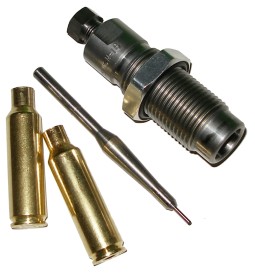
I used Lee Pacesetter dies for the project. I picked them up at MidwayUSA for under $25. The set includes a shell holder, full length sizer and seater/crimping dies. The dies were easy to set up, held adjustment and didn’t overwork the brass in the sizing operation.
The Pacesetter product utilizes a collet mounted tapered expander, making sizing effort low and results uniform. I have a bad habit of pushing the expander up in the die and out of the way when I am sizing new brass and not decapping. If this is done with a short necked sharp shouldered case, the expander, case neck and undersize die neck forming surface will all be in the same place at the same time and cause the case to bind on the ram upstroke. Other than the loose lug nut behind the handle, this is not a malfunction, just an improper die adjustment and one that can be duplicated with any manufacturer’s dies.
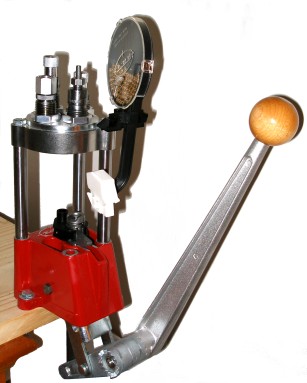 Handloading WSM cartridges doesn’t require an overpriced piece equipment that qualifies as a modern marvel of automation. A standard 4 hole Lee Turret Press with LPS priming system and Safety Prime set up was used to produce all of the handloads for this project. The output was of excellent quality and uniform in performance. Lee Equipment is like Star Trek Tribbles, the little furry things that are born pregnant and multiply whenever they eat. You buy one piece of Lee equipment, realize the practical and entertainment value, and start buying more. Pretty soon your shop is overrun with inexpensive red machines and related gadgets. I think Lee Precision is one of those companies that requires extra consideration and support from handloaders. They seem to like the business they are in and their customers, they put a lot of effort into product design and retail packages and creatively address handloading needs. Best of all, I have never seen them price gouge customers; for that alone they deserve continued success.
Handloading WSM cartridges doesn’t require an overpriced piece equipment that qualifies as a modern marvel of automation. A standard 4 hole Lee Turret Press with LPS priming system and Safety Prime set up was used to produce all of the handloads for this project. The output was of excellent quality and uniform in performance. Lee Equipment is like Star Trek Tribbles, the little furry things that are born pregnant and multiply whenever they eat. You buy one piece of Lee equipment, realize the practical and entertainment value, and start buying more. Pretty soon your shop is overrun with inexpensive red machines and related gadgets. I think Lee Precision is one of those companies that requires extra consideration and support from handloaders. They seem to like the business they are in and their customers, they put a lot of effort into product design and retail packages and creatively address handloading needs. Best of all, I have never seen them price gouge customers; for that alone they deserve continued success.
Shooting Impressions…
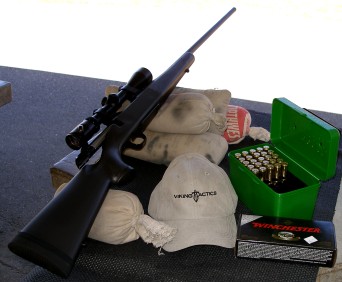
The Composite Stalker is a great little hunting rifle; durable finish, light to carry and very compact. Extensive range time has not diminished this opinion and I’m looking forward to carrying mine in the field this fall. I would be remiss if I didn’t mention that the combination of the little Browning, at only 7 1/2 lbs with scope and sling in place, barks and bites…just a little. Consuming an occasional box of ammo for the purposes of sighting in or staying sharp with the gun is reasonable. Sitting down at the bench and burning through a hundred rounds for the purpose of handload development probably is not. The 40 ft/lbs of recoil generated approaches the recoil of a 10 lb rifle chambered for the 375 H&H.
Most rifle designed for the purpose of hunting have little drop at the heel and the Composite Stalker is no exception. When fired, the muzzle tends not to climb skyward, making a follow up shot a faster proposition, and an upright shooter tends to roll with recoil even when it is directed straight back at the shooter’s shoulder. I thought the recoil wasn’t more then a little annoying. My wife, whose favorite rifle is a 257 Weatherby Magnum UltraLight, had a slightly different opinion. What else is new? This is not a mild cartridge – rifle combination. For a firearm of the 300 Winchester Magnum or 338 Winchester Magnum power class, some recoil reality should be expected.
But can it hit anything….
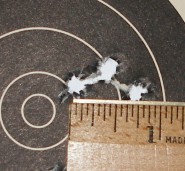
Shooting off of a mountain of sandbags, through a Burris Fullfield scope cranked up to 9x magnification, I was able to hammer out groups that ranged in size from 3/4″ to 1 1/4″. There were some notable occurrences within the day’s noisemaking, coffee drinking, semi socializing, and bad joke telling target shooting. For example, three, three shot groups representing two different bullet weights, three bullet types and 9 different powder charges all fell within 1 3/4″ inches or so, of one another. That is great point of impact performance and should instill a lot of confidence in the rifle’s performance when hunting.
 Angered over a $60 price tag on a box of Winchester Supreme Ballistic Silvertip ammo, and its excessively long and pretentious descriptive name, I looked forward to writing, “Factory ammo would not group better than 10″ or so”. Unfortunately I could not. 180 grain Ballistic Tip ammo not only grouped consistently less than an inch, but the chronographed shot to shot performance was within a foot per second or two; 3044 – 3046 fps. The Winchester advertised velocity for this load is 3060 fps, but that is based on a 24″ barrel and the Browning barrel is only 23″. Very good product, but too steep in price for me and I was able to do better with a $10 box of handloads. Did I mention I really like this rifle and cartridge combination?
Angered over a $60 price tag on a box of Winchester Supreme Ballistic Silvertip ammo, and its excessively long and pretentious descriptive name, I looked forward to writing, “Factory ammo would not group better than 10″ or so”. Unfortunately I could not. 180 grain Ballistic Tip ammo not only grouped consistently less than an inch, but the chronographed shot to shot performance was within a foot per second or two; 3044 – 3046 fps. The Winchester advertised velocity for this load is 3060 fps, but that is based on a 24″ barrel and the Browning barrel is only 23″. Very good product, but too steep in price for me and I was able to do better with a $10 box of handloads. Did I mention I really like this rifle and cartridge combination?
Over the chronograph…
| Company | Weight Grains |
Bullet Type |
COL | Net Capacity |
Powder Type |
Charge Weight |
CCI Primer |
Projected Velocity |
Actual Velocity |
| Hornady | 150 | Interlock | 2.831 | 76.5 | Varget | 68.5 | #250 | 3264 | 3231 |
| Hornady | 150 | Interlock | 2.831 | 76.5 | H4350 | 74.0 | #250 | 3160 | 3203 |
| Hornady | 150 | Interlock | 2.831 | 76.5 | H4350 | 76.6 C | #250 | 3283 | 3308 |
| Hornady | 150 | Interlock | 2.831 | 76.5 | RS Hunter | 78.5 | #250 | 3354 | 3318 |
| Remington | 185 | PSP | 2.830 | 73.7 | H4350 | 71.5 | #250 | 3004 | 3021 |
| Remington | 185 | PSP | 2.830 | 73.7 | RS Hunter | 73.0 | #250 | 3055 | 3023 |
| Remington | 185 | PSP | 2.830 | 73.7 | Re 22 | 75.0 | #250 | 3002 | 2900 |
| Remington | 185 | PSP | 2.830 | 73.7 | Re 22 | 76.5 C | #250 | 3070 | 2985 |
| Remington | 185 | PSP | 2.830 | 73.7 | IMR 7828 SSC | 76.5 C | #250 | 3076 | 3005 |
| Hornady | 195 | SP | 2.860 | 72.5 | H414 | 68.0 | #250 | 2914 | 2885 |
| Hornady | 195 | SP | 2.860 | 72.5 | H4350 | 70.0 | #250 | 2930 | 2907 |
| Hornady | 195 | SP | 2.860 | 72.5 | Re22 | 75.0 C | #250 | 3008 | 2890 |
| Hornady | 195 | SP | 2.860 | 72.5 | IMR 7828 SSC | 75.0 C | #250 | 3003 | 2930 |
| Nosler | 200 | Partition | 2.815 | 71.4 | H4350 | 70.0 | #250 | 2913 | 2883 |
| Nosler | 200 | Partition | 2.815 | 71.4 | RS Hunter | 70.0 | #250 | 2932 | 2900 |
| Nosler | 200 | Partition | 2.815 | 71.4 | Re 22 | 73.5 C | #250 | 2957 | 2852 |
| Nosler | 200 | Partition | 2.815 | 71.4 | IMR 7828 SSC | 73.6 | #250 | 2968 | 2868 |
| Nosler | 200 | Partition | 2.815 | 71.4 | MagPro | 77.0 | #250 | 2950 | 2742 |
| Nosler | 200 | Accubond | 2.870 | 69.5 | H4350 | 69.0 | #250 | 2903 | 2874 |
| Nosler | 200 | Accubond | 2.870 | 69.5 | RS Hunter | 69.0 | #250 | 2929 | 2891 |
| Nosler | 200 | Accubond | 2.870 | 69.5 | Re 22 | 72.5 | #250 | 2957 | 2800 |
| Nosler | 200 | Accubond | 2.870 | 69.5 | IMR 7828 SSC | 72.2 C | #250 | 2948 | 2796 |
| Nosler | 200 | Accubond | 2.870 | 69.5 | MagPro | 76.3 | #250 | 2966 | 2660 |
| Sierra | 220 | GameKing | 2.840 | 69.9 | Re 22 | 71.2 C | #250 | 2844 | 2717 |
| Sierra | 220 | GameKing | 2.840 | 69.9 | IMR 7828 SSC | 71.0 | #250 | 2842 | 2734 |
| Sierra | 220 | GameKing | 2.840 | 69.9 | MagPro | 74.8 | #250 | 2852 | 2622 |
In summary…
I haven’t had a lot of direct experience with the Browning A Bolt, I am not sure why. I have received a lot of mixed signals from owners. Again, I am not sure why. The moderately priced A-Bolt Composite Stalker is a gem. The fit and finish is excellent, the composite stock is well designed to achieve strength and light weight and the gun is a serious shooter. I like the hex receiver and smooth bolt sleeve and even that nifty skewed flat bolt handle. For those who like a Euro look, you may want to check out an A-Bolt FLD. This model has increased drop at the heel and a high comb, raised cheek piece satin finished walnut stock. I like the idea of a removable box magazine hiding under the floor plate. Just like I like the detachable magazine in my Remington Mountain rifle. I am pretty sure I won’t use the Browning magazine feature anymore than I load up my second magazine for the Remington, but it is nice to know it is there. The need just never comes up in real life and $50 to hold 3 more WSM rounds is a little too steep for me. The shotgun type safety is nice, easy to operate and where it would be expected to be found.
I like the 325 WSM a lot. I have firearms with more punch, but I think this is about all that is needed for North America, within any ranges I would consider. I’m guessing even the 150 grain loads would be excellent for deer and similar, 195 or 200 for most anything else including big pigs, black bear, elk, etc. The tough 200 grain loads and 220 grain loads I would guess to be more than adequate for larger bear. If I needed something bigger for North America or elsewhere, I would skip the 338 Winchester Magnum, which doesn’t really handle heavy bullets, and use my 338-378 Weatherby that does. Yup, impressive all around rifle and cartridge.
Thanks,
Joe

Email Notification